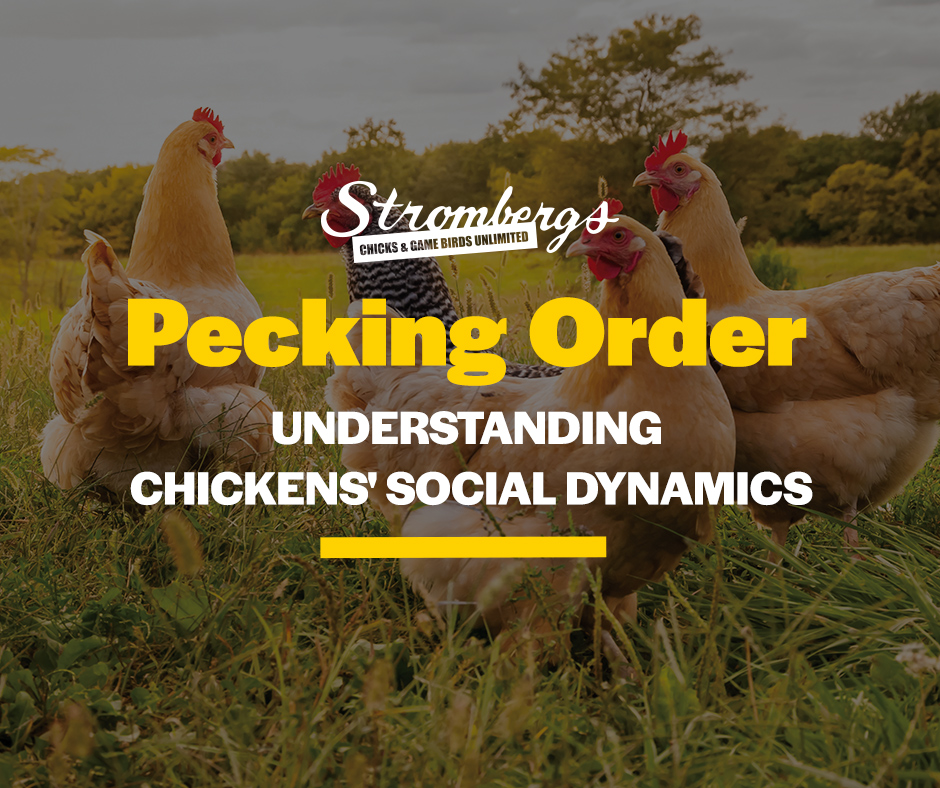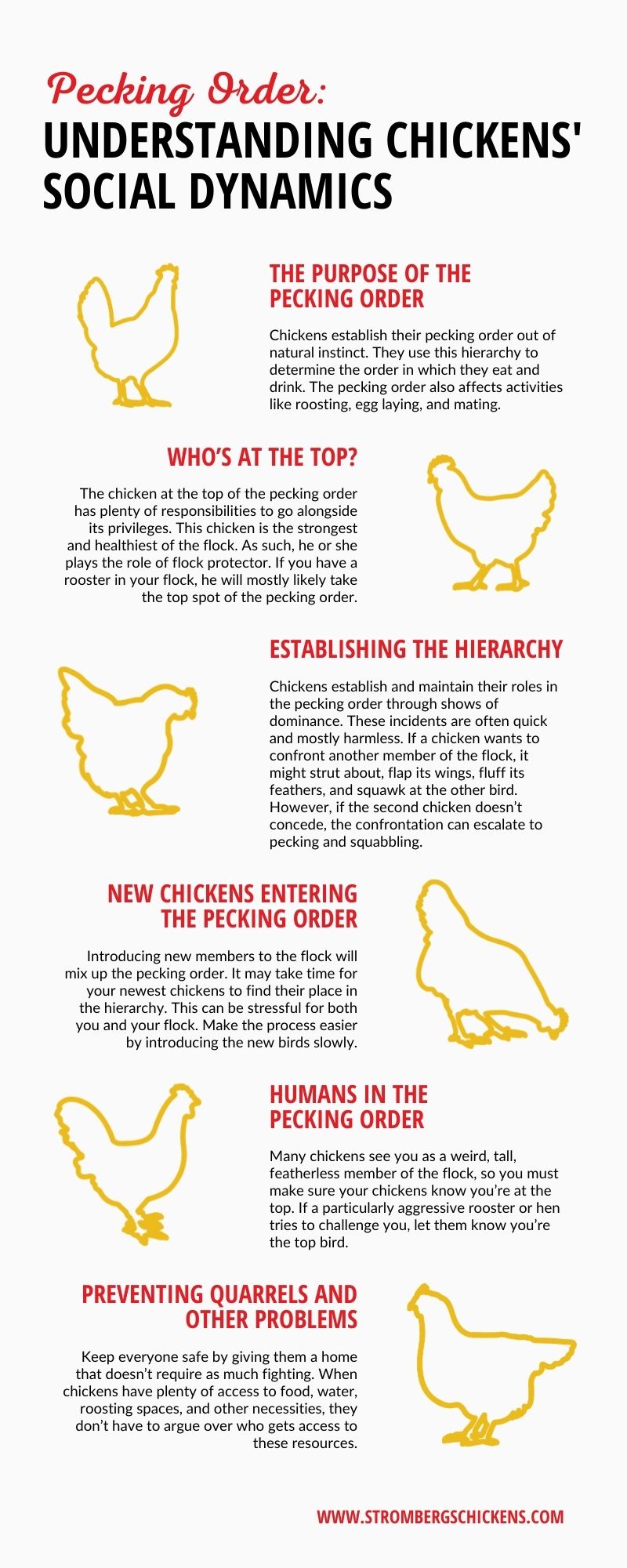Pecking Order: Understanding Chickens’ Social Dynamics
Chickens are social creatures. They play and explore together, satisfying their curiosity and need for companionship.
However, like many social animals, a chicken flock must establish a dominance hierarchy to figure out how things work around the coop. This hierarchy is known as the pecking order. Chickens use the pecking order to establish who in the flock is more dominant.
While the idea of the pecking order may seem violent, it can help keep order in the coop as your chickens establish their roles in the flock’s dynamic. Chicken keepers should understand how the pecking order works and why it’s important. The more you know, the better chance you have of helping your flock’s hierarchy run smoothly and without too much squabbling.
Learn everything you need to know about the pecking order with this guide to understanding chickens’ social dynamics.

THE PURPOSE OF THE PECKING ORDER
Chickens establish their pecking order out of natural instinct. They use this hierarchy to determine the order in which they eat and drink. The pecking order also affects activities like roosting, egg-laying, and mating.
Much of a chicken’s life is influenced by its place in the pecking order. Stronger, more dominant chickens at the top of the order get first access to food, water, and treats. They also get their pick of roosting space. Chickens at the lower end of the pecking order must wait their turn for these things.
When lower-ranked chickens try to usurp their flock members by getting to these things first, they’ll get knocked back into place with a peck or other show of dominance. Of course, these rankings aren’t always permanent. As chickens age and new members join the flock, everyone’s place in the pecking order can shift. Some dominant chickens will even relinquish their spot as they grow older or tired of their duties.
WHO’S AT THE TOP?
The chicken at the top of the pecking order has plenty of responsibilities to go alongside its privileges. This chicken is the strongest and healthiest of the flock. As such, he or she plays the role of flock protector. They practice constant vigilance, keeping an eye out for predators and other dangers to their little feathery family.
If a hawk flies overhead, the chicken at the top of the pecking order is the one to herd the flock to the safety of the coop. If there are disputes between other members of the flock, the alpha chicken will step in to settle it. Some flock mates will even stand back and let the rest of the flock eat first while they keep watch.
If you have a rooster in your established flock, he will most likely take the top chicken spot of the pecking order. If you have other roosters in the flock, they’ll take their natural places throughout the hierarchy.
With no roosters in a flock, an older, stronger and dominant hen will take the role of alpha for flock management. That said, young pullets tend to be less violent with their shows of dominance, leading to a calmer establishment of the pecking order.
ESTABLISHING THE HIERARCHY
As we mentioned above, chickens establish and maintain their roles in the pecking order through shows of dominance. These incidents are often quick and mostly harmless.
If a chicken wants to confront another member of the flock, it might strut about, flap its wings, fluff its feathers, and squawk at the other young birds. Sometimes that’s all it takes, and the other member of the flock will concede, establishing that the challenger is higher than they are in the pecking order.
However, if the second chicken doesn’t concede, the confrontation can escalate to pecking and squabbling. This might also end quickly with nothing more than a few lost feathers. However, if neither chicken backs down, they will keep fighting. In extreme situations, this can lead to serious injury or even death.
While establishing the pecking order is natural, you want to keep an eye on your flock. Once a squabble escalates to the point of drawing blood, it’s time to break it up and separate the birds for a while.
NEW CHICKENS ENTERING THE PECKING ORDER
Introducing new members to the flock will mix up the pecking order. It may take time for your newest chickens to find their place in the hierarchy. This can be stressful for both you and your flock.
Make the process easier by introducing the new birds slowly. You can section off a portion of the coop or run to hold your new chickens for a week or so. This will allow the birds to get to know each other without physically sharing space, preventing immediate and violent squabbling.
Once the initial wariness and aggravation fade, try letting the new birds out to meet the rest of the flock fully. Squabbling will likely occur, but your chickens will usually settle their issues quickly and develop a new pecking order that everyone can live with.
HUMANS IN THE PECKING ORDER
Part of understanding chickens’ social dynamics and the pecking order is understanding your place in it. Many chickens see you as a weird, tall, featherless member of the flock, so you must make sure your chickens know you’re at the top.
If a particularly aggressive head rooster or hen tries to challenge you, let them know you’re the top bird. Never run from an attacking chicken. Instead, try to grab the chicken and hold it gently but firmly to the ground.
Once it calms down, you can let it up again. Repeat this process as needed, and after a couple of incidents, the chicken should respect your place as master of the flock.
However, some chickens—usually roosters—continue to be aggressive toward their humans. An overly aggressive bird can be both annoying and dangerous, especially if you have younger children running around.
If you can’t correct the behavior, you might want to consider getting rid of the chicken by giving it to a different home or using your chicken processing equipment. If you rehome an aggressive chicken, ensure the future owner is aware of their behavior and ready to handle the challenge.
PREVENTING QUARRELS AND OTHER PROBLEMS
The pecking order is natural, and chickens usually work things out amongst themselves with no real harm. A particularly aggressive chicken or a constantly squabbling flock can be a serious headache. Constant quarrels also put your chickens in danger. Keep everyone safe by giving them a home that doesn’t require as much fighting.
When chickens have plenty of access to food, water, roosting spaces, and other necessities, they don’t have to argue over who gets access to these resources. Lighting can also stress out your flock. If you have lights in the coop, make sure they aren’t too bright and limit them to only 16 hours a day or less. This will help keep your chickens calm and happy.
In conclusion, when you can prevent serious squabbles, the pecking order can be fascinating, enlightening, and even entertaining. What stories do you have about your beloved flock’s pecking order? Share your tales with us in the comments below.


